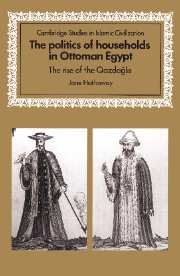Book contents
- Frontmatter
- Contents
- Note on transliteration
- List of illustrations
- List of tables
- Preface
- List of abbreviations
- Genealogical tables
- Introduction
- I The household and its place in Ottoman Egypt's history
- Chapter 1 Egypt's place in the Ottoman Empire
- Chapter 2 The household
- Chapter 3 Transformations in seventeenth- and eighteenth-century Egyptian military society
- Chapter 4 The emergence and partnership of the Qazdağli and Jalfi households
- Chapter 5 The ascendancy of Ibrahim Kâhya al-Qazdağli and the emergence of the Qazdağli beylicate
- II Qazdağli household-building strategies
- Glossary
- Bibliography
- Index
Chapter 4 - The emergence and partnership of the Qazdağli and Jalfi households
Published online by Cambridge University Press: 22 September 2009
- Frontmatter
- Contents
- Note on transliteration
- List of illustrations
- List of tables
- Preface
- List of abbreviations
- Genealogical tables
- Introduction
- I The household and its place in Ottoman Egypt's history
- Chapter 1 Egypt's place in the Ottoman Empire
- Chapter 2 The household
- Chapter 3 Transformations in seventeenth- and eighteenth-century Egyptian military society
- Chapter 4 The emergence and partnership of the Qazdağli and Jalfi households
- Chapter 5 The ascendancy of Ibrahim Kâhya al-Qazdağli and the emergence of the Qazdağli beylicate
- II Qazdağli household-building strategies
- Glossary
- Bibliography
- Index
Summary
As the Qazdağli household took shape within the Janissary regiment, its development was paralleled and shadowed by that of the Jalfi household, which appeared several decades later than the Qazdağlis but came to dominate the ʿAzeban regiment at roughly the same time that the Qazdağlis were consolidating their hold over the Janissary corps. After years of flirting with both the Qazdağlis and their chief rivals within the Faqari bloc, the house of Zülfikar Bey, the Jalfis forged a long-lasting alliance of subordination with the Qazdağlis that would nurture the Qazdağli enterprise and shape the Qazdağli style of rule through the middle of the eighteenth century. For the historian, the Jalfi household is a useful study in contrast to the Qazdağli group and, perhaps, an example of the role the Qazdağlis themselves might have taken had circumstances been different: a far smaller, far less complex household that proved a reliable second fiddle. To understand the workings of the early Qazdağli household, we must come to a complementary understanding of the workings of the early Jalfis.
Jalfi origins
The name Jalfi first appears in the registers of imperial orders known as mühimmes in 1715. Three salient features distinguish this household and perhaps determine, in large measure, its behavior in Egyptian military society. First of all, the Jalfis appear to have been a relatively small and uncomplicated household, comprising only one major line of affiliation. They were therefore untroubled by competing branches.
- Type
- Chapter
- Information
- The Politics of Households in Ottoman EgyptThe Rise of the Qazdaglis, pp. 52 - 87Publisher: Cambridge University PressPrint publication year: 1996



